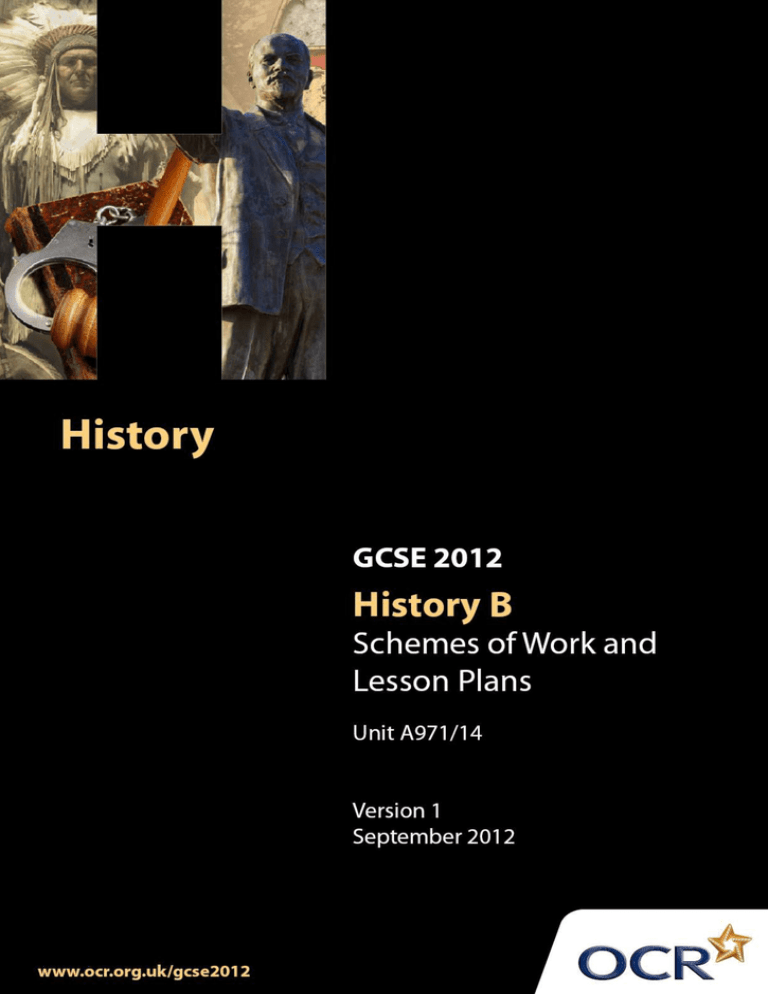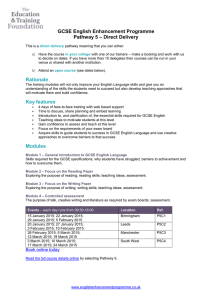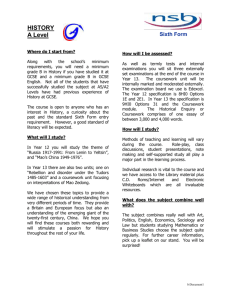Unit A971/14 and A014 - Mao’s China c.1930-1976 - Sample scheme of work and lesson plan booklet (DOC, 876KB)
advertisement

© OCR 2009 Contents Contents 2 Introduction 3 Sample Scheme of Work: Unit A971/14: Mao’s China c.1930–76 5 Sample Lesson Plan: Unit A971/14: Mao’s China c.1930–76 2 of 14 13 GCSE History B (Modern World) Introduction Background Following a review of 14–19 education and the Secondary Curriculum Review, the Qualifications and Curriculum Authority (QCA) has revised the subject criteria for GCSEs, for first teaching in September 2009. This applies to all awarding bodies. The new GCSEs have more up-to-date content and encourage the development of personal, learning and thinking skills in your students. We have taken this opportunity to redevelop all our GCSEs, to ensure they meet your requirements. These changes will give you greater control of assessment activities and make the assessment process more manageable for you and your students. Controlled assessment will be introduced for most subjects. From September 2012 assessment tasks may be undertaken at any point between release of the task and the examination series for which the task must be submitted. Centres must ensure that candidates undertake a task that is valid for submission in the year in which the candidate intends to submit it. OCR has produced a summary brochure which summarises the changes to History. This can be found at www.ocr.org.uk, along with the new specification. In order to help you plan effectively for the implementation of the new specification we have produced these Schemes of Work and Sample Lesson Plans for History. These Support Materials are designed for guidance only and play a secondary role to the Specification. Our Ethos OCR involves teachers in the development of new support materials to capture current teaching practices tailored to our new specifications. These support materials are designed to inspire teachers and facilitate different ideas and teaching practices. Each Scheme of Work and set of Sample Lesson Plans is provided in Word format – so that you can use it as a foundation to build upon and amend the content to suit your teaching style and students’ needs. The Scheme of Work and sample Lesson plans provide examples of how to teach this unit and the teaching hours are suggestions only. Some or all of them may be applicable to your teaching. The Specification is the document on which assessment is based and specifies what content and skills need to be covered in delivering the course. At all times, therefore, this Support Material GCSE History B (Modern World) 3 of 14 booklet should be read in conjunction with the Specification. If clarification on a particular point is sought then that clarification should be found in the Specification itself. A Guided Tour through the Scheme of Work = Innovative Teaching Idea This icon is used to highlight exceptionally innovative ideas. = ICT Opportunity This icon is used to illustrate when an activity could be taught using ICT facilities. 4 of 14 GCSE History B (Modern World) Sample GCSE Scheme of Work UNIT A971/14: MAO’S CHINA C.1930–1976 1 SUGGESTED TEACHING TIME 6 HOURS TOPIC OUTLINE WHAT WAS CHINA LIKE IN THE FIRST HALF OF THE TWENTIETH CENTURY? TOPIC SUGGESTED TEACHING AND HOMEWORK ACTIVITIES SUGGESTED RESOURCES POINTS TO NOTE THE LAST EMPEROR (DVD) WALSH, B. (1996) GCSE MODERN WORLD HISTORY, JOHN MURRAY (P. 262-3) 1 HOUR = Innovative teaching idea GCSE History B (Modern World) KEY QUESTION 1: WHY DID CHINA BECOME A COMMUNIST STATE? STUDENTS NEED A BRIEF INTRODUCTION TO IMPORTANT FEATURES OF CHINA’S HISTORY FOREIGN INTERVENTION AND THE ANCIENT CHINESE CULTURE. THIS SHOULD INCLUDE DETAILS OF - THE LAST EMPEROR, PUYI (1908 1912), OVERTHROWN IN A REVOLUTION BY CHINESE NATIONALISTS LED BY SUN YATSEN - ESTABLISHMENT OF KUOMINTANG/ GUOMINDANG AND ALLIANCE WITH NEW COMMUNIST PARTY (FORMED 1921) - SIZE OF COUNTRY AND NATURE OF POPULATION (PEASANTRY, INTERNAL DIVISIONS) BUSHNELL, N. (2006) CHINA FOR GCSE, ZIG ZAG EDUCATION (P. 4) VOCABULARY/CONCEPTS: EMPEROR WAR LORDS MAO TSE-TUNG (ZEDONG) INTERNAL DISSENSION CIVIL WAR PRODUCE A POSTER/ TIMELINE TO ILLUSTRATE AND EXPLAIN THE KEY EVENTS IN CHINA’S HISTORY FROM 1911 TO 1925 = ICT opportunity 5 of 14 Sample GCSE Scheme of Work UNIT A971/14: MAO’S CHINA C.1930–1976 SUGGESTED TEACHING TIME 6 HOURS TOPIC OUTLINE = Innovative teaching idea 6 of 14 TOPIC KEY QUESTION 1: WHY DID CHINA BECOME A COMMUNIST STATE? SUGGESTED TEACHING AND HOMEWORK ACTIVITIES SUGGESTED RESOURCES POINTS TO NOTE = ICT opportunity GCSE History B (Modern World) Sample GCSE Scheme of Work 1 UNIT A971/14: MAO’S CHINA C.1930-1976 SUGGESTED TEACHING TIME 6 HOURS TOPIC OUTLINE Why did the Communists start the Long March? TOPIC SUGGESTED TEACHING AND HOMEWORK ACTIVITIES SUGGESTED RESOURCES POINTS TO NOTE Steward, G. (2006) China, 1900-76, Heinemann Walsh, B. (1996) GCSE Modern World History, John Murray (p. 263-4) Chiang Kai-shek/Jiang Jieshi Bushnell, N. (2006) China for GCSE, Zig Zag Education (p. 5) Democracy 2 hours = Innovative teaching idea GCSE History B (Modern World) KEY QUESTION 1: WHY DID CHINA BECOME A COMMUNIST STATE? Students need to understand the tensions between the Nationalists and Communists after the death of Sun Yat-sen This should include details of - The rule of Chiang Kai-shek and the war against the warlords - The changing nature of GMD’s relationship with Communists after 1927 - Imprisonment of Mao and Communist retreat to Jianxi/ Kiangsi - 1934 Communist decision to find a more secure base - The Long March: motives, 7000m journey to Yenan by 80 000 Communists, guerrilla campaign fought en-route, high numbers of casualties Vocabulary/ concepts: Nationalists Nationalism Socialism Communism Produce a 6 scene cartoon summarising the key facts of the Long March = ICT opportunity 7 of 14 Sample GCSE Scheme of Work UNIT A971/14: MAO’S CHINA C. 1930–1976 SUGGESTED TEACHING TIME 6 HOURS TOPIC OUTLINE How far was the Long March a success? 1 hour KEY QUESTION 1: WHY DID CHINA BECOME A COMMUNIST STATE? SUGGESTED TEACHING AND HOMEWORK ACTIVITIES SUGGESTED RESOURCES POINTS TO NOTE Steward, G. (2006) China 1900 - 76, Heinemann Walsh, B. (1996) GCSE Modern World History, John Murray (p. 264) Bushnell, N. (2006) China for GCSE, Zig Zag Education (p. 5) = Innovative teaching idea 8 of 14 TOPIC Students need to understand the consequences of the Long March and its significance This should include details of - Different views about the success of the Long March - Communist Party propaganda - Impact of Mao’s leadership (the 8 principles of the Red Army) - Response of Chinese peasants to Red Army Produce a typical and credible piece of Communist Party propaganda from 1936 (text or image), celebrating the Long March In groups, prepare arguments for class discussion on why both the Chinese Communists and the Kuomintang claimed the Long March had been a success for them Vocabulary/concepts Propaganda Martyr Guerrilla warfare = ICT opportunity GCSE History B (Modern World) Sample GCSE Scheme of Work UNIT A971/14: MAO’S CHINA C.1930–1976 1 SUGGESTED TEACHING TIME 6 HOURS TOPIC OUTLINE How far did the Second World War weaken the Nationalist government and strengthen the Communists? 2 hours TOPIC SUGGESTED TEACHING AND HOMEWORK ACTIVITIES SUGGESTED RESOURCES POINTS TO NOTE Lynch, M. (1998) The People’s Republic of China since 1949, Hodder and Stoughton Walsh, B. (1996) GCSE Modern World History, John Murray (p. 264 - 6) Scorched earth policy Bushnell, N. (2006) China for GCSE, Zig Zag Education (p. 6) People’s Liberation Army (PLA) = Innovative teaching idea GCSE History B (Modern World) KEY QUESTION 1: WHY DID CHINA BECOME A COMMUNIST STATE? Students must consider the differing approaches of the Communists and the Nationalists during the invasion of Japan, and the aftermath of the Second World War in China This should include details of - Relations between China and Japan prior to 1937 (Manchuria 1931) - Changing response of Chiang Kai-shek to Japanese, resulting in the Second United Front - Retreat of Nationalists to Sichuan and the scorched earth policy - Brutal treatment of peasants in Japanese AND Nationalist-controlled areas - Chiang’s diversion of supplies sent by Britain and USA - Lin Biao’s leadership of Communist forces and the guerrilla tactics of the Red Army Vocabulary/ concepts Second United Front Red Army Atomic bomb = ICT opportunity 9 of 14 Sample GCSE Scheme of Work UNIT A971/14: MAO’S CHINA C.1930-1976 SUGGESTED TEACHING TIME 6 HOURS TOPIC OUTLINE Why did the Communists win the Civil War? 1 hour = Innovative teaching idea 10 of 14 TOPIC KEY QUESTION 1: WHY DID CHINA BECOME A COMMUNIST STATE? SUGGESTED TEACHING AND HOMEWORK ACTIVITIES - 1945 ATOMIC BOMBS DROPPED BY USA, FOLLOWED BY THE RESUMPTION OF CIVIL WAR - CHIANG’S CORRUPT FORCES WERE INCREASINGLY DISCREDITED; THE SETTING UP OF THE PLA, FOLLOWED BY CHIANG’S FLIGHT TO TAIWAN IN GROUPS, PRODUCE A MIND MAP SHOWING THE IMPACT OF THE WAR AGAINST JAPAN ON VARIOUS GROUPS IN CHINA, SUCH AS THE NATIONALISTS, COMMUNISTS, PEASANTS, CHILDREN ETC Students need to understand and analyse the range of long term and short term reasons which explain the Communist victory in 1949 SUGGESTED RESOURCES Short, P. (1999) Mao: a Life, John Murray Walsh, B. (1996) GCSE Modern World History, John Murray (p. 267 - 8) Bushnell, N. (2006) China for GCSE, Zig Zag Education (p. 7) POINTS TO NOTE = ICT opportunity GCSE History B (Modern World) Sample GCSE Scheme of Work 1 UNIT A971/14: MAO’S CHINA C.1930–1976 SUGGESTED TEACHING TIME 6 HOURS TOPIC OUTLINE TOPIC SUGGESTED TEACHING AND HOMEWORK ACTIVITIES = Innovative teaching idea GCSE History B (Modern World) KEY QUESTION 1: WHY DID CHINA BECOME A COMMUNIST STATE? SUGGESTED RESOURCES POINTS TO NOTE THIS SHOULD INCLUDE DETAILS OF THE RELATIVE SIGNIFICANCE OF - RED ARMY’S GUERRILLA TACTICS - MAO’S LEADERSHIP - CORRUPTION WITHIN NATIONALISTS - CHIANG’S POOR LEADERSHIP - THE ROLE OF THE PEASANTS - JAPANESE INVASION USE LARGE WHITE BOARDS TO BRAINSTORM AND MIND MAP - FACTORS THAT CONTRIBUTED TO THE COMMUNIST VICTORY IN THE CIVIL WAR - LINKS BETWEEN THE FACTORS AND THEIR RELATIVE IMPORTANCE = ICT opportunity 11 of 14 Sample GCSE Scheme of Work UNIT A971/14: MAO’S CHINA C.1930–1976 SUGGESTED TEACHING TIME 6 HOURS TOPIC OUTLINE TOPIC SUGGESTED TEACHING AND HOMEWORK ACTIVITIES = Innovative teaching idea 12 of 14 KEY QUESTION 1: WHY DID CHINA BECOME A COMMUNIST STATE? SUGGESTED RESOURCES POINTS TO NOTE USE THIS AS PREPARATION FOR ANSWERING THE QUESTION - ‘HOW FAR DO YOU AGREE THAT THE MOST IMPORTANT REASON WHY THE COMMUNISTS WON THE CIVIL WAR IN 1949 WAS THE INFLUENCE OF THE RED ARMY’? = ICT opportunity GCSE History B (Modern World) Sample GCSE Lesson Plan Unit A971/14: Mao’s China c.1930–1976 (As part of a two-hour investigation into how far the Second World War weakened the Nationalist government and strengthened the Communists) What was the impact of the Japanese invasion on support for the Nationalist government? OCR recognises that the teaching of this qualification will vary greatly from school to school and from teacher to teacher. With that in mind this lesson plan is offered as a possible approach but will be subject to modification by the individual teacher. Lesson length is assumed to be one hour. Learning Objectives for the Lesson Objective 1 To develop understanding of the Nationalist response to the Japanese invasion. Objective 2 To analyse primary sources effectively to investigate the impact of Japanese occupation and Nationalist policies after 1937. To consolidate understanding of the impact of Japanese occupation on support for the Nationalist government by empathising with Chinese citizens and predicting a list of typical and credible demands. Objective 3 Recap of Previous Experience and Prior Knowledge Students have already studied an overview of China in the first half of the twentieth century and the causes and impact of the Long March. Content Time Content 5 minutes Display quotation from Chiang Kai-shek, 1936: (starter) “The Japanese are a disease of the skin, it can be cured. The Communists are a disease of the soul; it affects the whole body”. Brainstorm ideas on the meaning and implications of Chiang’s words. Can you guess how Chiang intended to deal with the Japanese invasion? 10 minutes (development) Present pupils with keys facts on Japan and past relations with China, including Manchurian invasion of 1931. In small groups, consider Chiang’s options in 1937 and come up with an assessment of 3 possible courses of action (advantages and disadvantages). Eg Unite with Communists temporarily? GCSE History B (Modern World) 13 of 14 Sample GCSE Lesson Plan Time Content 20 minutes Pupils must match images to descriptions to create a summary of the key features of Chiang’s chosen policies after 1937: 15 minutes - formation of the Second United Front - retreat of Nationalists to Sichuan - the scorched earth policy - brutal treatment of peasants in Nationalist-controlled areas - Chiang’s diversion of supplies sent by Britain and USA. Link each of these images/descriptions to the quotation used in the starter activity. What does this source show about life for Chinese citizens during the Japanese invasion? Use primary sources to generate discussion about the nature of, and similarities between, Japanese and Nationalist rule after 1937. For example, extracts from Wild Swans (Jung Chang 1991, HarperCollins) vividly depict the brutality of Japanese occupation, and there are many cartoons online highlighting contemporary views on the corruption of Nationalist officers at this time. Consolidation Time Content 10 minutes (plenary) In small groups, pupils can compose a list of demands for Mao from ordinary Chinese citizens. These must emphasise 14 of 14 - why they are against Japanese occupation - in what ways they feel let down by the Nationalist government - exactly what they want Mao and his Communist supporters to do to improve the lives of ordinary Chinese citizens. GCSE History B (Modern World)







